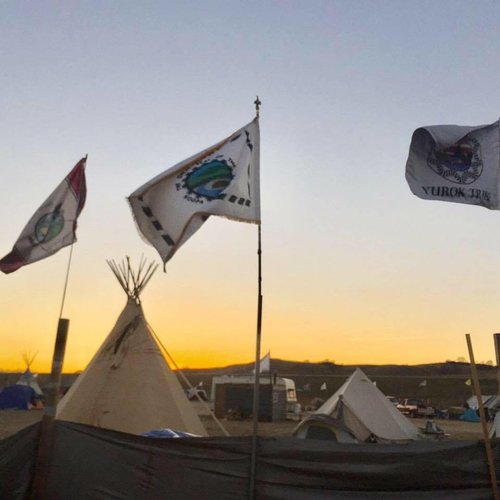Defending Standing Rock
When: August 2016 - December 2016
Where: Sioux Territory, North Dakota
In 2016, there was a national emergency in Indian Country, and a plea for assistance went out for allies and Tribal communities to gather at the location of encounter near the Standing Rock Sioux Reservation in North Dakota. Over 150 Tribal Nations and allies were in a standoff at the confluence of the Missouri and Cannonball rivers over plans for a 3.7 billion dollar crude oil pipeline that would run just outside of the boundary of the Standing Rock North Dakota Reservation. Pipeline construction would disturb sacred ceremonial sites, and there was fear it would pollute local drinking and ground water.
The direct threat of the Dakota Access Pipeline polluting sacred water, and refusal to comply with Federal treaties called Tribes of the Lower Klamath Basin to respond. The Bear River, Yurok, and Hoopa Tribes all publicly affirmed their commitment to stand with Standing Rock. The National Congress of American Indians and United Nations also declared support.
“Standing Rock is something the Native Community has been waiting for a long time. We know when tribes unify, they have tremendous ability, and the more people on the ground in Standing Rock, the bigger the movement we will build. The environment is our religion, we are standing for all people.”
According to the Seattle Times, “More than 1,500 people from 150 tribes and their supporters from around the country...gathered at the confluence of the Cannonball and Missouri rivers, staging a nonviolent protest at what they call a spirit camp”. True North Organizing Network answered the call to support local Tribal members and allies to join the camp in North Dakota. On Friday, September 2nd, True North sent a second delegation of almost 50 Yurok, Karuk, and Hoopa Tribal members to North Dakota to set up a kitchen to feed the massive gathering of tribal members and allies. Local Native youth have been at the forefront of Klamath Basin support at standing rock.
“I have never been more proud to be an Native person than I am today. People who had never even heard of Cannonball, ND before the pipeline project (such as myself) told stories of how they quit their jobs, sold their belongings, or sacrificed in various other ways in order to make the trip out to stand with Standing Rock and the Sioux Nation against the Dakota Access Pipeline. On top of that, we witnessed over 90 tribes from across the country coming together in both prayer and action, greeting each other with the same love you would with close friends. This gathering, which is only continuing to gain momentum as we speak, is a testament to the incredible strength that is witnessed when tribes unite against the outside exploitation of our land, water, and cultures, which we have all been facing for centuries.”
“People need to be at Standing Rock because the more people that stand up the more attention we will get. And when we as a people (no matter what race you are) unite big things will happen.”
